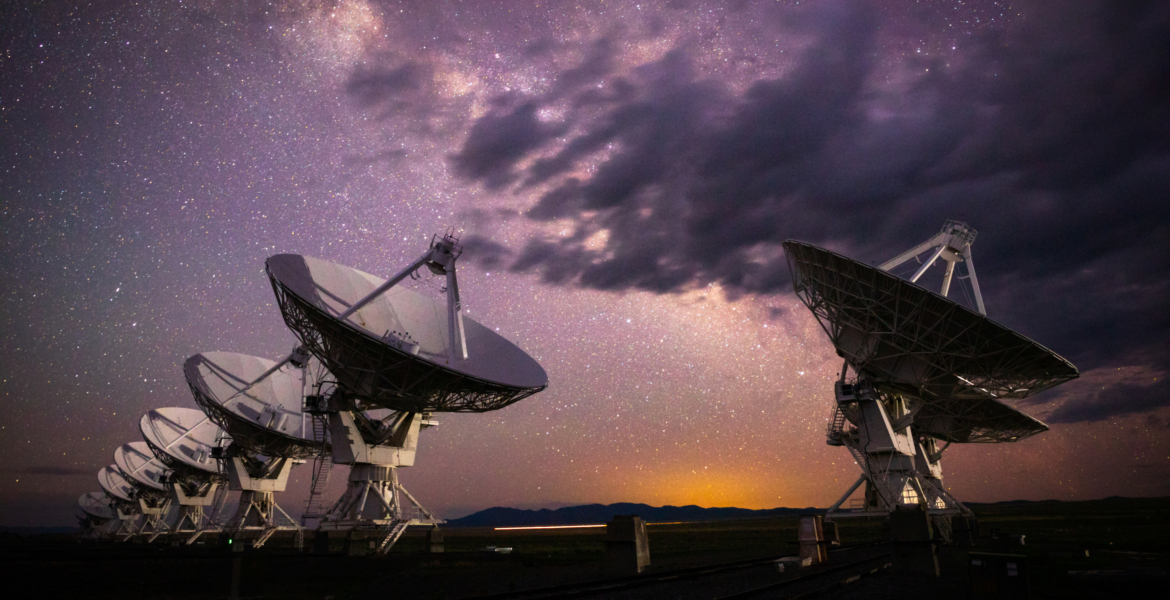Towards the center of our Milky Way Galaxy, in the constellation Sagittarius, astronomers have discovered 10 monstrous neutron stars. These particular stars, called pulsars, reside together in globular cluster Terzan 5, a crowded home for hundreds of thousands of different types of stars. In one of the most jam-packed places in our Milky Way, many pulsars in Terzan 5 have evolved into bizarre and eccentric forms.
Recent News
Old Data, New Tricks Discover Pulsar in Galactic Plane
A team of astronomers has found a new tool to discover pulsars, rapidly rotating neutron stars that blast out pulses of radiation at regular intervals ranging from seconds to milliseconds. Named the VLA Low-band Ionosphere and Transient Experiment (VLITE), the tool was made possible by a collaboration between the U.S. Naval Research Laboratory and the National Radio Astronomy Observatory.
AUI and the NRAO Announce Recipients of the 2024 NAC Bridge Scholarship Award
In its fourth year, the AUI Board of Trustees NAC Bridge Scholarship Award recognizes the academic accomplishments of National Astronomy Consortium (NAC) alums and assists them in the transition from undergraduate to graduate programs.
SETI Institute Unlocks Mysteries of the Universe with Breakthrough Technology at the VLA

Image Credit: Bettymaya Foott, NRAO/AUI/NSF
In a groundbreaking cosmic quest, the SETI Institute’s Commensal Open-Source Multimode Interferometer Cluster (COSMIC) at the Karl G. Jansky Very Large Array (VLA) is expanding the search for extraterrestrial intelligence (SETI). This cutting-edge technology is not a distinct telescope; it’s a detector. COSMIC searches for extraterrestrial signals and paves the way for future science using a copy of the raw data from the telescope’s observations. At the heart of COSMIC’s mission is pursuing the age-old question: Are we alone in the universe? Project scientist Dr. Chenoa Tremblay and the team detailed the project in a paper published this week in The Astronomical Journal.
What sets COSMIC apart is its adaptability to the future. The system is designed for future upgrades, ensuring it remains at the forefront of cosmic exploration. With the potential to expand its capabilities, COSMIC could soon cover more stars, explore new frequencies, and enhance our understanding of the vast cosmic tapestry. It is important to note that COSMIC’s capabilities go beyond searching for extraterrestrial intelligence. Future upgrades could unlock new explorations, from finding fast radio bursts with a submillisecond temporal resolution to studying spectral line science and axionic dark matter.
“COSMIC introduces modern Ethernet-based digital architecture on the VLA, allowing for a test bed for future technologies as we move into the next generation era,” said Tremblay. “Currently, the focus is on creating one of the largest surveys for technological signals, with over 500,000 sources observed in the first six months. However, the flexibility of the design allows for a wide range of other scientific opportunities, such as studying fast radio burst pulse structures and searching for axion dark matter candidates. We hope to open opportunities for other scientists to use our high time (nanoseconds) or our high spectral resolution (sub-Hz) to complete their research. It is an exciting time for increasing the capabilities of this historic telescope.”
COSMIC stands on the shoulders of giants like Project Phoenix, with the capacity to search millions of stars and the potential to expand to tens of millions—a leap in scope and sensitivity. Currently operational on the VLA, COSMIC is searching using observations from the Very Large Array Sky Survey (VLASS), which will map 80% of the sky in three phases over two years and catalog approximately 10 million radio sources.
COSMIC’s Ethernet-based system adds a new collaborative element to the cosmos. The multicasting technology allows other commensal systems to access COSMIC’s processing power, enabling a collaborative scientific ecosystem to develop. Imagine multiple telescopes working together to unlock the universe’s most profound mysteries.
“The COSMIC system greatly enhances the VLA’s scientific capabilities. Its main goal of detecting extraterrestrial technosignatures addresses one of the most profound scientific questions ever. This topic was previously not possible with the VLA,” said Dr. Paul Demorest, National Radio Astronomy Observatory. “By operating in parallel with projects such as the VLA Sky Survey, COSMIC will accomplish one of the largest SETI surveys ever while still allowing the VLA to carry out its usual program of other astronomical research.”
Read this original press release on the SETI website.
This news article was originally published on the NRAO website on January 8, 2024.
Recent News
Telescope Tag-Team Discovers Galactic Cluster’s Bizarre Secrets
Towards the center of our Milky Way Galaxy, in the constellation Sagittarius, astronomers have discovered 10 monstrous neutron stars. These particular stars, called pulsars, reside together in globular cluster Terzan 5, a crowded home for hundreds of thousands of different types of stars. In one of the most jam-packed places in our Milky Way, many pulsars in Terzan 5 have evolved into bizarre and eccentric forms.
Old Data, New Tricks Discover Pulsar in Galactic Plane
A team of astronomers has found a new tool to discover pulsars, rapidly rotating neutron stars that blast out pulses of radiation at regular intervals ranging from seconds to milliseconds. Named the VLA Low-band Ionosphere and Transient Experiment (VLITE), the tool was made possible by a collaboration between the U.S. Naval Research Laboratory and the National Radio Astronomy Observatory.
AUI and the NRAO Announce Recipients of the 2024 NAC Bridge Scholarship Award
In its fourth year, the AUI Board of Trustees NAC Bridge Scholarship Award recognizes the academic accomplishments of National Astronomy Consortium (NAC) alums and assists them in the transition from undergraduate to graduate programs.
